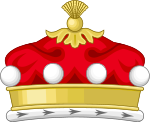
Baron Sudeley is a hereditary title that has been created three times in the history of Britain, twice in the Peerage of England and once in the Peerage of the United Kingdom. The first creation came in the Peerage of England in 1299 when John de Sudeley was summoned to Parliament as Lord Sudeley. On the death of the third Baron in 1367 the title fell into abeyance. The abeyance was terminated in 1380 when Thomas Boteler, the fourth Baron, became the sole heir. The sixth Baron was created Baron Sudeley by letters patent in 1441. He served as Lord High Treasurer from 1444 to 1447. On his death in 1473, the 1441 creation became extinct while the 1299 creation once again fell into abeyance.
Contents
- Barons Sudeley; First and Second creation (1299 and 1441)
- Barons Sudeley; Third creation, 1838
- Line of Succession
- Arms
- See also
- Notes
- References
- External links
The third creation came in the Peerage of the United Kingdom in 1838 when Charles Hanbury-Tracy was created Baron Sudeley, of Toddington in the County of Gloucester. [1] He had previously represented Tewkesbury in the House of Commons as a Whig and served as Lord Lieutenant of Montgomeryshire. He was also Chairman of the Royal Commission appointed to judge designs for the new Houses of Parliament. He married his cousin Henrietta Susanna, daughter and heiress of Henry Leigh Tracy, 8th and last Viscount Tracy, through which marriage the estate of Toddington Manor in Gloucestershire came into the Hanbury family. Five days before the marriage Charles Hanbury assumed the additional surname of Tracy.
He was succeeded by his son, the second Baron. He sat as a Member of Parliament for Wallingford and served as Lord Lieutenant of Montgomeryshire. In 1806 Lord Sudeley assumed by Royal licence the surname of Leigh in lieu of his patronymic. However, in 1839 he discontinued the use of this surname and resumed by Royal licence his original surname of Hanbury-Tracy. On his death, the title passed to his son, the third Baron. He was also Lord Lieutenant of Montgomeryshire. He was succeeded by his younger brother, the fourth Baron. He was a Liberal Member of Parliament for Montgomery from 1863 to 1877 and served under William Ewart Gladstone as Captain of the Corps of Gentlemen-at-Arms in 1886. However, he later came into financial difficulties which caused the sale of the family seat of Toddington Manor.
The title is currently held by the eighth Baron (a member of the collateral branch of the family), who succeeded the seventh Baron on 5 September 2022.


